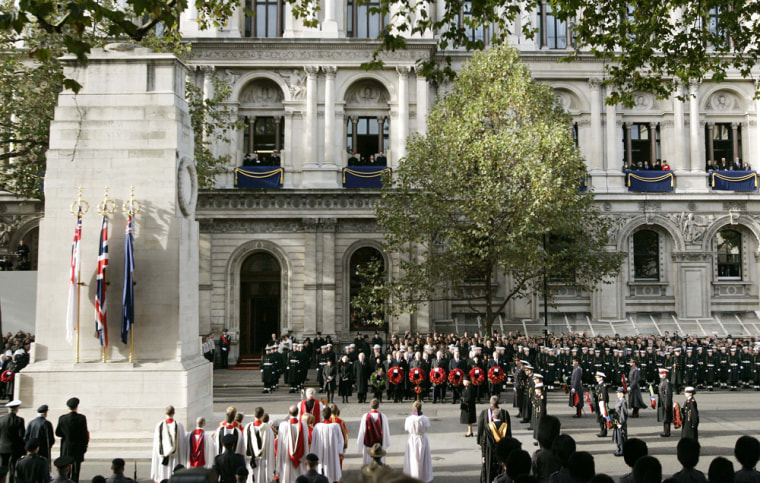LONDON — As parades go, it was a small-town moment on a big day of remembrance. No sign of royalty, of bishops or bands.
Instead a hundred souls or so, led by volunteer musicians, marching down the High Street to pay homage to those of Berkhamsted town who gave their lives for our country.
In the vanguard, veterans in their civvies suits, their chests glittering with medals and swollen with pride. Stiff in limb, short of breath, long in the tooth, these old men stood to attention in front of the memorial to comrades who had died during the two world wars and the conflicts that followed.
But for one old soldier, the day became another battle.
A day of poppies
Some 35 miles away, in the center of London, the cleaning up was already under way after another parade of commemoration.
The country’s most symbolic war memorial, the Cenotaph, was as ever the focus of the nation’s attention on Remembrance Day.
The Queen and her princes, the prime minister and his government, ambassadors from around the world, gathered to pay homage to the fallen, as their predecessors have done at this spot for more than 80 years.
After two minutes of silence, the laying of wreaths began and some 8,000 veterans — sometimes represented by their children or grandchildren — marched proudly past this monument to the dead.
Within minutes the foot of the monument was the color of blood, covered in red poppies, the symbol that has come to represent the sacrifice of war.
The veterans were applauded by the many thousands of spectators who lined the streets of central London. They were watched by millions at home on TV. It was, indeed, a moving sight. The day was as it should be.
‘Rolls of honor’
There are some 36,000 war memorials in the United Kingdom, built after the unprecedented loss of life in World War I. Almost a million soldiers from the British Empire died in the 1914-18 conflict.
Ironically these tableaus began as "rolls of honor" — erected by local communities to recognize the sacrifice of the men who had gone off to fight. When they didn’t come back, they became their memorials.
Young men from the same neighborhoods volunteered in their hundreds and thousands to fight in local battalions — the Bradford "Pals," the Grimsby "Chums."
When they went into battle, they went in side by side and they died that way. As was the British custom, their bodies were buried close to where they fell.
And so the memorials became the focal point of an unprecedented outpouring of public grief. Soon they were springing up in every village and town in the country, a history of each place’s contribution to war and of each community’s losses.
Here the names of fathers, sons and brothers (few women are commemorated) rest side by side in stony perpetuity, representing — if nothing else — the years of grief and loss their families must endure.
In my home the war against Hitler was the background noise of my childhood. We didn’t talk of history, of grand designs, of whether it was right or wrong. My parents, uncles and aunts reminisced about the blackout, the bombings, the rations, their time in the forces, the friends they lost.
In our house, Remembrance Day was not a day for politics, for arguing about the ethics or morality of war. It was, and still is, about honoring ordinary people who found themselves caught up in conflict and who put their sense of duty and lives before themselves.
Old soldier fights on
And so it was this week in my town of Berkhamsted. By comparison with the Cenotaph, ours was a homespun parade.
The brass band was a rag-tag civilian army that played better than it looked or marched. The old standard-bearers, uncertain of their way, took a wrong turn until muffled cries in the ranks behind set them right.
But when they came to a halt, they stood as tall as any old soldiers could. Except for one, whose knees buckled as he slowly collapsed onto the pavement.
There, in the midst of a ceremony to commemorate the fallen of war, this old-timer began a fight for his own life.
First his comrades, then bystanders, moved to his aid. I went to try to lift him up, but he was already unconscious.
I held his head in my hands, tipping it to one side, all I could remember from my basic first-aid training.
I watched, with relief, the old boy’s heavy breathing and then, frozen, as it stopped.
I do not know what battles, if any, this soldier had fought in his younger days. But I know the one he fought that day, as medics pummeled his chest, blew air into his mouth, sent electric shocks through his body.
Strangely, like a casualty in a firefight, the commemoration went on around him, most participants seemingly ignorant of the seriousness of his situation.
Man down. Medics. Stretcher-bearer. The images were poignant and painful.
Around him, blood-red wreaths of poppies, and a bugler sounding the Last Post.
Another Remembrance Day, never to be forgotten.*
